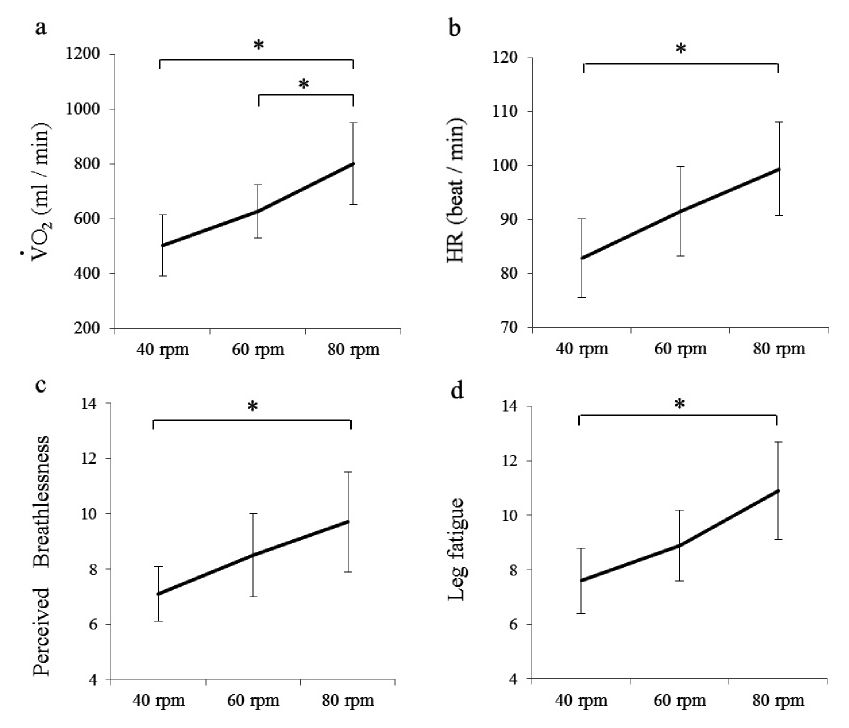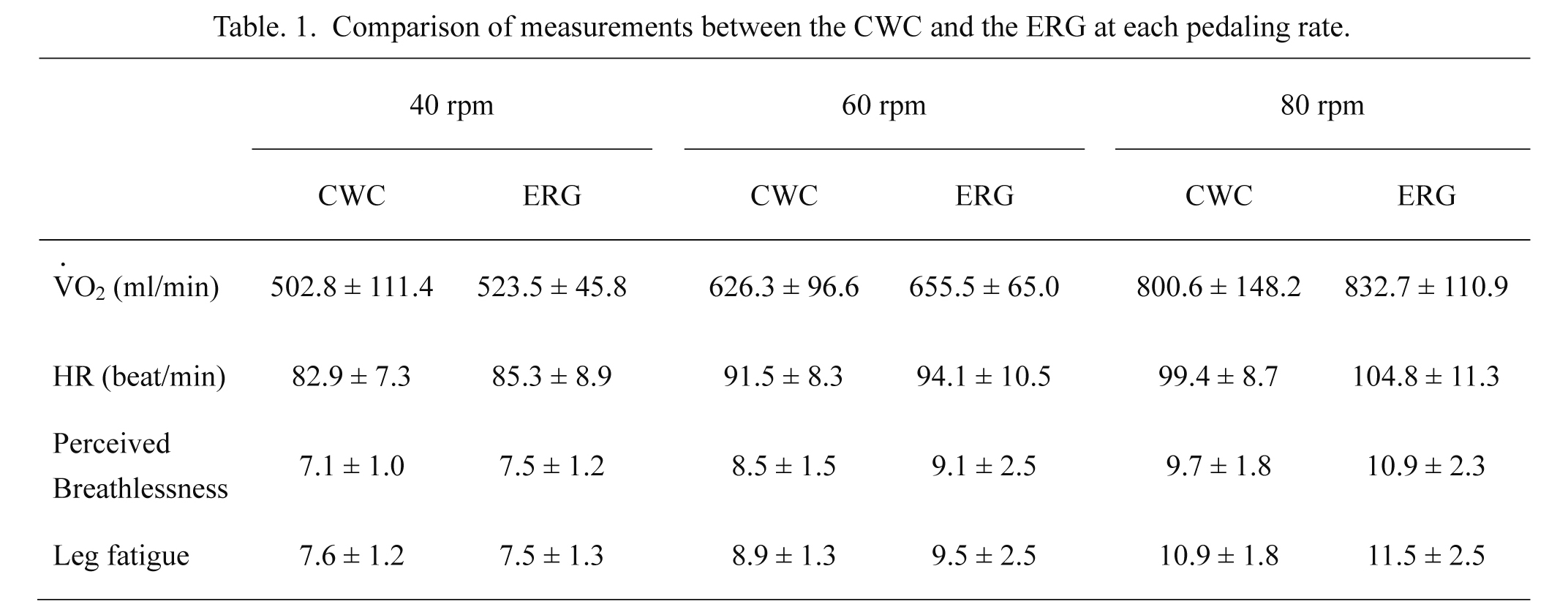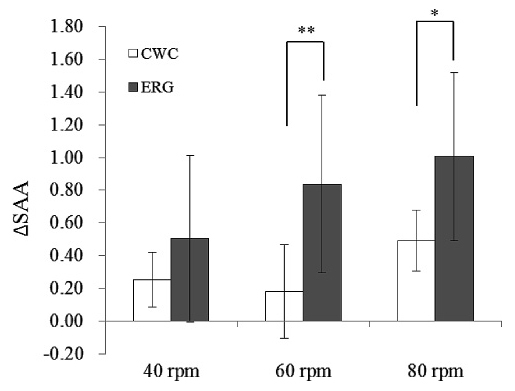Abstract
The cycling wheelchair (CWC) can be used as a pedaling exercise machine. However, physiological indexes in the CWC at various pedaling rates and the difference between the CWC and the existing pedaling machines such as the portable ergometer (ERG) are unclear. The aim of this study was to measure physiological indexes in the CWC at various pedaling rates and compare the CWC to the ERG, focusing on psychological stress. The present non-randomized crossover study included ten healthy men (22.3 ± 1.2 years) who performed pedaling exercise with the CWC and the ERG. Both experiments were composed of three pedaling exercise sessions (40, 60, and 80 rpm). Physiological indexes, consisting of oxygen consumption, heart rate, perceived breathlessness and leg fatigue, and salivary amylase activity (SAA), an index of psychological stress, were measured. The metabolic equivalent (METs) and the rate of change in SAA from rest to immediately after each pedaling session (ΔSAA) were calculated. In the CWC, all physiological indexes significantly increased with pedaling rates. The METs were 2.2 ± 0.3, 2.7 ± 0.4, and 3.5 ± 0.4 at 40, 60, and 80 rpm, respectively. In comparison between the CWC and the ERG, ΔSAA was lower in the CWC than in the ERG at 60 and 80 rpm. Our results indicate that the CWC pedaling can provide low or moderate intensity exercises with adjusting pedaling rates and is less stressful than the ERG. Thus, the CWC is a useful pedaling machine to promote regular and enjoyable exercises.
Introduction
In recent years, cycling wheelchair (CWC) has been developed as a new type of wheelchair with a pedaling system for self locomotion and pedaling exercise and a steering system controlled by one hand (Seki et al. 2004). This wheelchair may be useful even for people who have difficulty in walking due to cerebrovascular or neurological diseases. Some studies have reported the CWC use for locomotion (Seki and Handa 2005; Makino et al. 2005). The moving distance with the CWC was longer than that with an ordinary wheelchair in elderly persons in a long-term care health facility (Seki and Handa 2005). Also, the CWC was superior to the ordinary wheelchair in driving speeds and efficiency for hemiplegic patients (Makino et al. 2005). Other studies have reported the effects of CWC pedaling exercise (Seki et al. 2009; Sekiya et al. 2009). Seki et al. (2009) reported that pedaling exercise performed with the CWC induced muscle activity in paretic legs and Sekiya et al. (2009) showed that pedaling exercise with the CWC improved physical function in hemiplegic patients. These studies suggested that the CWC was useful not only as an implement for locomotion, but also as an exercise machine (Seki and Handa 2005; Makino et al. 2005; Seki et al. 2009; Sekiya et al. 2009). However, each experiment was conducted using free pedaling rates and did not take into account the influence of pedaling rates. In pedaling exercise, physiological indexes such as oxygen consumption (VO2) or heart rate (HR) increase with increasing pedaling rates. To perform pedaling exercise safely and effectively using the CWC in clinical settings, it is necessary to clarify these physiological indexes at different pedaling rates. Nevertheless, the change in physiological indexes with increasing the CWC pedaling rates has not been clarified even in young volunteers.
The CWC has recently come to be used in clinical fields. However, sitting pedaling machines, like a portable ergometer (ERG), are also available for use. For the wide spread use of the CWC in the clinical field, comparison with an existing pedaling machine is necessary in order to indicate the usability of the CWC as a new pedaling exercise machine. One of the key differences between the CWC and the ERG is the capability of moving around. People can perform pedaling exercise while moving around using the CWC. On the other hand, pedaling exercise with the ERG is performed in a fixed place. Soeda (2011) reported that treadmill walking increased salivary amylase activity (SAA), a sympathetic nervous system stress marker, whereas level ground walking did not. This suggested that stationary exercise may affect the stress level of the user. Therefore, pedaling exercise with the CWC could be less stressful than that with the ERG, even if the exercise intensity and the form are the almost same. However, no research has been reported to compare the CWC and the ERG in stress level after pedaling exercise.
The first aim of the present study was to measure physiological indexes with the CWC at different pedaling rates. The second aim was to compare stress level after pedaling exercise with the CWC to that after pedaling exercise with the ERG.
Materials and Methods
Subjects
Ten healthy male subjects [age; 22.3 ± 1.2 years, height; 171.8 ± 5.5 cm, weight; 63.5 ± 9.0 kg (mean ± standard deviation: SD)] volunteered to participate in this study. All subjects had no signs or symptoms of neurological disease or orthopedic impairment in their lower limbs. Before their participation, all subjects were properly informed about the study and signed written consent forms, in accordance with the Declaration of Helsinki. The present study was performed with the approval given by the Ethics Committee of the Kobe University Graduate School of Health Sciences.
Materials
This study consisted of two experiments with CWC and ERG cycling conditions. For the CWC exercise, a Profhand (TESS Co., Ltd., Sendai, Japan) (see Fig. 1a) was used. In this machine, the pedals are connected to the right wheel and the subjects pedaled using both legs alternately. Direction is controlled by the steering wheel, which is operated by a hand lever. For ERG exercise, a Monark 881E (Monark, Stockholm, Sweden) was used. Subjects pedaled the ERG in the same sitting position as the CWC (Fig. 1). Moreover, because to equal the exercise intensity between the CWC and the ERG, the workload of the ERG was set to 10 W at 50 rpm to take into account the friction between the floor and the tire of the CWC.
Environment
This study was a non-randomized crossover study. Each experiment was performed at the same time on different days and the experiments were conducted more than one day apart. The subjects were required to refrain from training, drinking (alcohol or caffeine) during the previous 24 hours, and eating during the previous 2 hours. Subjects performed a brief practice of driving and pedaling before each experiment.
Protocol
Both experiments were composed of three pedaling exercise sessions. Each session was defined by the pedaling rate per minute (40, 60, and 80 rpm). First, subjects rested in a sitting position for 10 minutes to familiarize themselves with the environment (Rest 1), and thereafter, they performed pedaling exercise at 40, 60, and 80 rpm in order. Each pedaling session was 10 minutes long and was separated by a 5 minute rest (Fig. 2). All pedaling rates were established with an electronic metronome. Both experiments were performed in a gymnasium. A 60-meter elliptical course was set out on the level floor for the CWC.
Measurements
Physiological indexes, consisting of VO2, HR, perceived breathlessness, and leg fatigue and SAA were measured in this study. VO2 was measured using expired air collected in Douglas bags. Expired air for 3 minutes was collected four times in each experiment: at Rest 1 (from 6 to 9 minutes) and during each pedaling session (last 3 minutes). The metabolic equivalent (METs) was calculated using the following equation: METs = VO2 during exercise/VO2 during Rest 1.
A Polar HR monitor (Polar Electro, Kempele, Finland) was used to measure. HR during the experiment and the mean HR over 3 minutes was calculated during collection of expired air. Perceived breathlessness and leg fatigue was obtained immediately after each session using the Borg Scale (6-20). We used SAA to measure human psychological stress immediately after pedaling exercise. SAA can be an easy, quick, and non-invasive measure of human psychological stress and has been used in other studies (Takai et al. 2004; van Stegeren et al. 2008). SAA level was measured after 2 minutes of beginning Rest 1 and immediately after each session. All saliva samples were collected with an amylase monitor chip (Nipro, Osaka, Japan) which was placed under the tongue for 1 minute in order to collect whole saliva. The SAA (kU/L) was analyzed with a salivary amylase monitor (Nipro, Osaka, Japan). The rate of change in SAA (ΔSAA) was calculated using the following equation:
ΔSAA = (SAA immediately after each pedaling session − SAA at Rest 1)/SAA at Rest 1
Statistics
A one-way analysis of variance (ANOVA) with repeated measures was used to determine overall differences in Measurements across 40, 60, and 80 rpm in the CWC. If a significant F ratio was obtained, further analysis was performed using a Tukey’s honestly significant difference post-hoc test to identify the differences between selected variables. Additionally, a paired t-test was performed to examine differences in all physiological indexes and ΔSAA at each pedaling exercise sessions between the CWC and the ERG. A value of p < 0.05 was defined as the limit for statistical significance.
Results
In the CWC, a significant effect of pedaling rates was found in VO2 (p < 0.05). VO2 increased with increasing pedaling rates from 40 to 80 rpm, but no statistically significant difference was found between 40 and 60 rpm (Fig. 3a). The METs in the CWC were 2.2 ± 0.3, 2.7 ± 0.4, and 3.5 ± 0.4 at 40, 60, and 80 rpm, respectively (VO2 at Rest 1: 231.3 ± 43.1 ml/min). HR, perceived breathlessness and leg fatigue changed similarly to VO2 and increased with increasing pedaling rates from 40 to 80 rpm, with the exception that no significant difference was found between 60 and 80 rpm (Fig. 3b, c, d).
No significant difference was detected between the CWC and ERG in VO2, HR, perceived breathlessness, and leg fatigue at each pedaling rate (Table 1). ΔSAA in the CWC was significantly lower than that in the ERG pedaling sessions at 60 (CWC: 0.18 ± 0.29, ERG: 0.84 ± 0.54, p < 0.01) and 80 rpm, (CWC: 0.49 ± 0.19, ERG: 1.01 ± 0.51, p < 0.05; Fig. 4)
Discussion
The first aim of this study was to measure physiological indexes during pedaling exercise with the CWC at different pedaling rates. VO2, HR, perceived breathlessness, and leg fatigue were measured and all indexes increased substantially, in linear fashion, as pedaling rates increased. Some studies, which have examined the same parameters during exercise with the cycling ERG, showed that VO2 and HR increased as pedaling rates increased in a constant workload (Chavarren and Calbet 1999; Ferreira et al. 2006) or zero workload (Foss and Hallen 2004; Tokui and Hirakoba 2007). Results of the present study were similar to the findings in these former studies, in that each physiological index of pedaling exercise with the CWC also increased with increasing pedaling rates. The exercise intensities calculated from VO2 during pedaling exercise with the CWC were approximately 2.2, 2.7, and 3.5 METs at 40, 60, 80 rpm, respectively. The American College of Sports Medicine (ACSM) has defined low intensity physical activity as less than 3.0 METs and moderate physical activity as from 3.0 to 6.0 METs (Haskell et al. 2007). Thus, pedaling exercise at 40 or 60 rpm in the CWC is low intensity exercise and at 80 rpm is moderate exercise. ACSM has recommended regular moderate exercise for not only young, but also middle and older adults. Low intensity exercise can also be important for a person of low fitness level, such as elderly (Gill et al. 2000) and cardiac patients (Franklin et al. 1983). Thus, the CWC would be a useful pedaling exercise machine for young to low fitness individuals by adjusting pedaling rates.
The second aim of the present study was to compare stress after pedaling exercise with the CWC to that with the ERG. SAA, a sympathetic nervous system stress marker, was measured in pedaling exercise with the CWC, and physiological indexes and ΔSAA were compared to that with the ERG. Although no difference was observed in physiological indexes between the CWC and the ERG, ΔSAA in the CWC was significantly lower than that in the ERG at 60 and 80 rpm. These results indicate that it was less stressful to drive the CWC than the ERG, even though the exercise intensity of driving the CWC was similar to performing pedaling exercise with the ERG. There are several explanations for the difference in stress between driving the CWC and the ERG. One is the difference in the mobility. Pedaling exercise with the ERG is performed in a fixed place. On the other hand, the CWC can move around during pedaling exercise. Little change of information from visual sensation during exercise may make exercise boring. Soeda (2011) reported that the SAA increased before and after treadmill walking, whereas a similar increase was not identified in level ground walking. The results of their study suggest that the difference in the mobility during exercise impacts stress and supports the results of the present study. The other reason for the difference could be the monotonous nature of the exercise. Yamaguchi et al. (2004) reported that the Kraepelin test, which is a monotonous mathematical question, increased the value of SAA indicating that monotonous work is likely to cause stress. Pedaling exercise with an ERG tends to be monotonous because the motion during exercise at a steady pedaling rate is lower leg rotation only. In contrast, driving the CWC requires the operation of a steering wheel and that would relieve monotony. Thus, pedaling exercise with the CWC suppressed stress, and that may lead to regular exercise performance.
There are some limitations in this study. The subjects were limited to healthy men and did not include elderly or hemiplegic patients that have been used in other CWC studies. Furthermore, in terms of stress, although the findings of the present experiment show that pedaling exercise with the CWC was less stressful than that with ERG, the experiment was confined to a gymnasium. One characteristic of the CWC is that people can perform pedaling exercise during daily locomotion. However, we did not consider the change in stress with daily life. In addition, this study was not randomized. Therefore, further randomized research is needed to investigate the effectiveness of the CWC for elderly or hemiplegic patients and in daily use.
Conclusion
The results of the present study indicate that physiological indexes increase with increasing CWC pedaling rate and that the CWC pedaling is low or moderate intensity exercise of by adjusting pedaling rates. Moreover, pedaling exercise with the CWC is less stressful than that with the ERG. The CWC may be a new useful machine to perform pedaling exercise safely and to promote regular exercise.
Conflict of Interest
The authors declare no conflict of interest.
Acknowledgments
The authors thank the subjects who participated in this study. This study was supported by Japan Science and Technology Agency Program for Revitalization Promotion; Matching Promotion (Development of Cycling Wheelchair with assist and braking control system).
References
-
Chavarren,
J. &
Calbet,
J.A.
(1999) Cycling efficiency and pedalling frequency in road cyclists. Eur. J. Appl. Physiol. Occup. Physiol., 80, 555-563.
-
Ferreira,
L.F.,
Lutjemeier,
B.J.,
Townsend,
D.K. &
Barstow,
T.J.
(2006) Effects of pedal frequency on estimated muscle microvascular O2 extraction. Eur. J. Appl. Physiol., 96, 558-563.
-
Foss,
O. &
Hallen,
J.
(2004) The most economical cadence increases with increasing workload. Eur. J. Appl. Physiol., 92, 443-451.
-
Franklin,
B.A.,
Pamatmat,
A.,
Johnson,
S.,
Scherf,
J.,
Mitchell,
M. &
Rubenfire,
M.
(1983) Metabolic cost of extremely slow walking in cardiac patients: implications for exercise testing and training. Arch. Phys. Med. Rehabil., 64, 564-565.
-
Gill,
T.M.,
DiPietro,
L. &
Krumholz,
H.M.
(2000) Role of exercise stress testing and safety monitoring for older persons starting an exercise program. JAMA, 284, 342-349.
-
Haskell,
W.L.,
Lee,
I.M.,
Pate,
R.R.,
Powell,
K.E.,
Blair,
S.N.,
Franklin,
B.A.,
Macera,
C.A.,
Heath,
G.W.,
Thompson,
P.D. &
Bauman,
A.
(2007) Physical activity and public health: updated recommendation for adults from the American College of Sports Medicine and the American Heart Association. Med. Sci. Sports Exerc., 39, 1423-1434.
-
Makino,
K.,
Wada,
F.,
Hachisuka,
K.,
Yoshimoto,
N. &
Ohmine,
S.
(2005) Speed and physiological cost index of hemiplegic patients pedalling a wheelchair with both legs. J. Rehabil. Med., 37, 83-86.
-
Seki,
K. &
Handa,
Y.
(2005) The use and the effect of a cycling wheelchair for long-term care health users. Jpn. J. Rehabil. Med., 42 Suppl., 142 (in Japanese).
-
Seki,
K.,
Sato,
M.,
Fujii,
T. &
Handa,
Y.
(2004) Driving a cycling chair without FES in the non-ambulatory hemiplegic patients. Proc. 9th Annual Conf. Intern. FES Soc., 245-246.
-
Seki,
K.,
Sato,
M. &
Handa,
Y.
(2009) Increase of muscle activities in hemiplegic lower extremity during driving a cycling wheelchair. Tohoku J. Exp. Med., 219, 129-138.
-
Sekiya,
T.,
Seki,
K. &
Handa,
Y.
(2009) Change of physical function after cycling wheel chair exercise for patients with walking disability. Japanese Society for Medical and Biological Engineering, 47, 411-416 (in Japanese, abstract in English).
-
Soeda,
T.
(2011) Difference of the stress in treadmill walking and level ground walking—Analysis and consideration from consciousness survey based on salivary amylase activity and semantic differential method—. Annual Report of The Tohoku Section of Japanese Physical Therapy Association, 23, 38-42 (in Japanese).
-
Takai,
N.,
Yamaguchi,
M.,
Aragaki,
T.,
Eto,
K.,
Uchihashi,
K. &
Nishikawa,
Y.
(2004) Effect of psychological stress on the salivary cortisol and amylase levels in healthy young adults. Arch. Oral. Biol., 49, 963-968.
-
Tokui,
M. &
Hirakoba,
K.
(2007) Effect of internal power on muscular efficiency during cycling exercise. Eur. J. Appl. Physiol., 101, 565-570.
-
van Stegeren,
A.H.,
Wolf,
O.T. &
Kindt,
M.
(2008) Salivary alpha amylase and cortisol responses to different stress tasks: impact of sex. Int. J. Psychophysiol., 69, 33-40.
-
Yamaguchi,
M.,
Kanemori,
T.,
Kanemaru,
M.,
Takai,
N.,
Mizuno,
Y. &
Yoshida,
H.
(2004) Performance evaluation of salivary amylase activity monitor. Biosens. Bioelectron., 20, 491-497.





